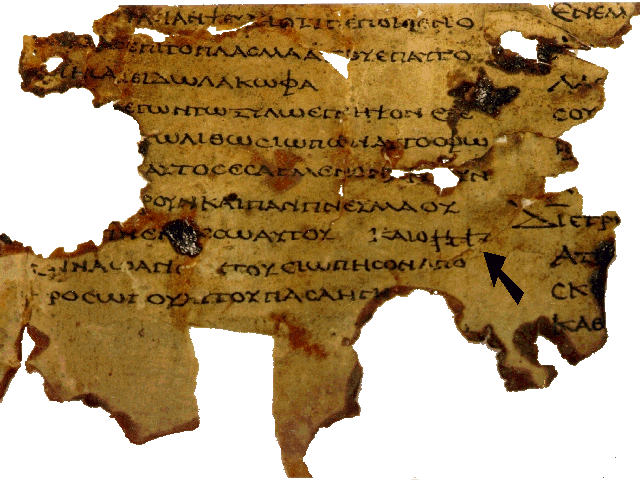Steven Avery
Administrator
Codex Hpaul - 015 - Coislinianus - Mt. Athos manuscript used for Sinaiticus correction
Kirsopp Lake
"Considering the close textual relationship between cod. Hpaul and the corrector Ca of the Codex Sinaiticus"
Note that this ms. is a fine exemplar for the old script.
============
Codex Coislinianus
https://en.wikipedia.org/wiki/Codex_Coislinianus
Codex Coislinianus designated by Hp or 015 (in the Gregory-Aland numbering), α 1022 (Soden),[1] was named also as Codex Euthalianus. It is a Greek uncial manuscript of the Pauline epistles, dated palaeographically to the 6th century. The text is written stichometrically.[2] It has marginalia. The codex is known for its subscription at the end of the Epistle to Titus.
============
The value of the codex is indicated by its subscription at the end of the Epistle to Titus:
Ἔγραψα καὶ ἐξεθέμην κατὰ δύναμιν στειχηρὸν τόδε τὸ τεῦχος Παύλου τοῦ ἀποστόλου πρὸς ἐγγραμμὸν καὶ εὐκατάλημπτον ἀνάγνωσιν… ἀντεβλήθη δὲ ἡ βίβλος πρὸς τὸ ἐν Καισαρίᾳ ἀντίγραφον τῆς βιβλιοθήκης τοῦ ἀγίου Παμφίλου χειρὶ γεγραμμένον αὑτοῦ.
I, Euthalius, wrote this volume of the Apostle Paul as carefully as possible in stichoi, so that it might be read with intelligence: the book was compared with the copy in the library at Caesarea, written by the hand of Pamphilus the saint.[9]
Almost the same note appears in Codex Sinaiticus in the Book of Ezra[5-Scrivener] and some Armenian manuscripts.[10
Scrivener (1894)
https://ccel.org/ccel/scrivener/ntcrit1/ntcrit1/Page_183.html
1861
https://books.google.com/books?id=6pOl5kos2O0C&pg=PA138

==============================
The surviving leaves of the codex contain:
1 Cor. 10:22–29, 11:9–16; 2 Cor. 4:2–7, 10:5–11:8, 11:12–12:4; Gal. 1:1–10, 2:9–17, 4:30–5:5; Col. 1:26–2:8, 2:20–3:11; 1 Thes. 2:9–13, 4:5–11; 1 Tim. 1:7–2:13, 3:7–13, 6:9–13; 2 Tim. 2:1–9; Titus 1:1–3, 1:15–2:5, 3:13–15; Hebr. 1:3–8, 2:11–16, 3:13–18, 4:12–15, 10:1–7, 10:32–38, 12:10–15, 13:24–25.
==============================
Codex H of the Pauline Epistles (1907)
F. G. Kenyon
https://books.google.com/books?id=3D9KAAAAMAAJ&pg=PA624
https://www.google.com/url?sa=t&rct...f?download=1&usg=AOvVaw1M_VyJ0Typbdw8-3OP-oDu
==============================
Kirsopp Lake
"Considering the close textual relationship between cod. Hpaul and the corrector Ca of the Codex Sinaiticus"
Note that this ms. is a fine exemplar for the old script.
============
Codex Coislinianus
https://en.wikipedia.org/wiki/Codex_Coislinianus
Codex Coislinianus designated by Hp or 015 (in the Gregory-Aland numbering), α 1022 (Soden),[1] was named also as Codex Euthalianus. It is a Greek uncial manuscript of the Pauline epistles, dated palaeographically to the 6th century. The text is written stichometrically.[2] It has marginalia. The codex is known for its subscription at the end of the Epistle to Titus.
============
The value of the codex is indicated by its subscription at the end of the Epistle to Titus:
Ἔγραψα καὶ ἐξεθέμην κατὰ δύναμιν στειχηρὸν τόδε τὸ τεῦχος Παύλου τοῦ ἀποστόλου πρὸς ἐγγραμμὸν καὶ εὐκατάλημπτον ἀνάγνωσιν… ἀντεβλήθη δὲ ἡ βίβλος πρὸς τὸ ἐν Καισαρίᾳ ἀντίγραφον τῆς βιβλιοθήκης τοῦ ἀγίου Παμφίλου χειρὶ γεγραμμένον αὑτοῦ.
I, Euthalius, wrote this volume of the Apostle Paul as carefully as possible in stichoi, so that it might be read with intelligence: the book was compared with the copy in the library at Caesarea, written by the hand of Pamphilus the saint.[9]
Almost the same note appears in Codex Sinaiticus in the Book of Ezra[5-Scrivener] and some Armenian manuscripts.[10
Scrivener (1894)
https://ccel.org/ccel/scrivener/ntcrit1/ntcrit1/Page_183.html
1861
https://books.google.com/books?id=6pOl5kos2O0C&pg=PA138
==============================
The surviving leaves of the codex contain:
1 Cor. 10:22–29, 11:9–16; 2 Cor. 4:2–7, 10:5–11:8, 11:12–12:4; Gal. 1:1–10, 2:9–17, 4:30–5:5; Col. 1:26–2:8, 2:20–3:11; 1 Thes. 2:9–13, 4:5–11; 1 Tim. 1:7–2:13, 3:7–13, 6:9–13; 2 Tim. 2:1–9; Titus 1:1–3, 1:15–2:5, 3:13–15; Hebr. 1:3–8, 2:11–16, 3:13–18, 4:12–15, 10:1–7, 10:32–38, 12:10–15, 13:24–25.
==============================
Codex H of the Pauline Epistles (1907)
F. G. Kenyon
https://books.google.com/books?id=3D9KAAAAMAAJ&pg=PA624
https://www.google.com/url?sa=t&rct...f?download=1&usg=AOvVaw1M_VyJ0Typbdw8-3OP-oDu
==============================
Last edited:


